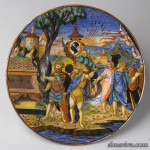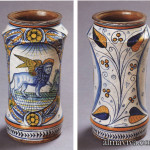Maiolica (sometimes majolica) is an Italian word used to describe the production of tin-glazed pavement tiles and pottery during the Renaissance period.
It is thanks to the Moors that the technique of tin-glazed earthenware was brought to Europe, in the so-called Al-Andalus, modern day Spain. First in Málaga, in Andalusia, and later on in the region of Valencia, these Hispano-Moresque wares were exported to Italy and to the rest of Europe. The term maiolica probably derives from the name of Majorca, main island of the Baleares archipelago, as decorated ceramics were extensively exported to Italy through these islands. Some scholars think the word comes from Málaga.
In Italy, the production of tin-glazed earthenwares started as early as in the fourteenth century. It reached a peak in the early sixteenth century when it was exported throughout Europe.
Maiolica is a technique where the decoration is painted onto an unbaked tin-glazed ceramic piece (see under-glaze). Once the decoration is finished, the piece is fired to a temperature of about 1,000° Celsius (1,820° Fahrenheit). Motifs ranged from portraits to coats of arms, ornamental designs, religious motifs, and scenes from the myths of antiquity. Maiolica is known as faïence (sometimes faience) in French and English.
Return to ceramic keywords






